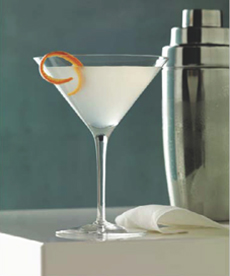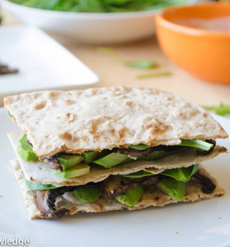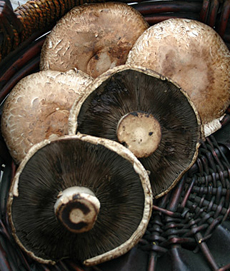|

[1] Chioggia beets, candy striped by nature (photo © Bee Raw).
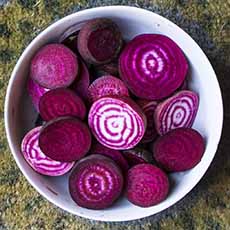
[2] A bowl of striped chioggia and conventional red beets (photo by Woodley Wonderworks | CC BY 2.0 License).
|
|
Some vegetables just engender a smile. For us, watermelon radish and chioggia beets are two of these, both charmingly candy striped by nature.
It’s so much fun to find them at farmers markets and add them to salads and crudité plates.
This show-stopping salad is made of raw chioggia (pronounced kee-OH-juh) beets, also known as bullseye beets, candy cane beets and candy stripe beets.
The chioggia is impressive for its dramatic presentation and in this recipe (photo at left) it is combined with other simple, bright flavors. A bonus: this variety of beet doesn’t bleed, which good news for those of us who have stained an item or two with beet juice.
The recipe is courtesy Bee Raw honey, which made it with their clover honey.
A beet-washing tip: While it can be tempting to scrub away at the beet skin with a vegetable brush, it’s delicate. Be gentle.
COOKING CHIOGGIA BEETS
If you think about cooking chioggia beets in another recipe, note that heat causes the pink rings to fade. They are best enjoyed raw.
Sadly, what nature giveth, nature taketh away. This also happens with other unusually colored foods, like purple asparagus.
You can boil them with a spoonful of lemon juice or white vinegar to keep the color from fading. But that’s why using them raw in a salad, or pickled, is ideal.
You can find chioggia beets at farmers markets and some specialty food markets. Note that if you’re storing the beets, first cut the greens from the root; then place them in separate plastic bags in the fridge.
|
RECIPE: RAW CHIOGGIA BEET SALAD WITH HONEY VINAIGRETTE
Ingredients For 4 To 6 Servings
3-4 medium chioggia beets (1-1/4 to 1-1/2 pounds) (substitute another beet variety if chioggia isn’t available)
1/4 cup pistachios (substitute edamame)
2 tablespoons extra virgin olive oil
2 tablespoons rice wine vinegar
2 tablespoons lime juice
2 teaspoons honey
Salt and pepper
Optional: We added sliced red onion (substitute green onions), a garnish of goat cheese (substitute feta) and a garnish of chopped fresh mint (substitute basil)
|
|
Preparation
1. WASH and dry the beets. Cut the beets into uniform matchstick-sized pieces; place in a medium to large bowl.
2. CHOP pistachios; set aside.
3. WHISK together the olive oil, vinegar, lime juice and honey in a small bowl. Toss with beets and optional onions. Season with salt and pepper to taste.
4. PLATE salads on individual plates and and sprinkle with pistachios and optional goat cheese and herbs. Serve immediately.
MORE ABOUT CHIOGGIA BEETS
Beets, Beta vulgaris, are a member of the Amaranth family, Amaranthaceae, along with lamb’s quarters, purslane, Swiss chard and quinoa, among many others. Heirloom chioggia beets were noted in northern Italy before 1840. They are named after a fishing village near Venice. The variety arrived in the U.S. prior to 1865.
|
|
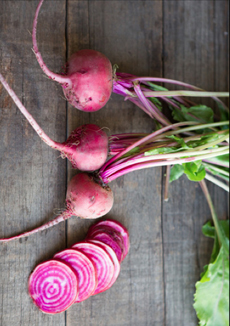
Chioggia beets, whole and sliced (photo © Good Eggs).
|
The light red skin looks like many other beets, but the candy striped white and red rings inside are a visual treat. The flesh is very tender, mild and sweet without the earthiness that some people don’t like in conventional red beets.
The beet is a root vegetable; it is known as beetroot in the U.K. and other Commonwealth countries. The wild beet is thought to have originated in prehistoric times in North Africa, and later grew wild along Asian and European seashores. Surprisingly, given the constant quest for food, early people ate the beet greens only.
The ancient Romans were among the first to cultivate beets and eat the roots. The tribes that invaded Rome after the fall carried beets throughout northern Europe. There, they were initially used as animal fodder and later for human consumption [source].
Beets became more popular in the 16th century but really became prominent in the 19th century, when it was discovered that they were a concentrated source of sugar.
Enjoy them baked, pickled, roasted, sautéed, steamed or sliced or grated raw in a salad. Consider baking them with yellow squash and/or zucchini and any herbs, tossed in olive oil for 30 minutes at 350°F (the pretty chioggia stripes will not survive the heat). These baked veggies are delicious plain, but toward the end you can add grated cheese for a gratiné.
You can also toss in leftover chicken, meat or fish, and a top of mashed potatoes (like shepherd’s pie).
Don’t forget to sauté the beet greens. Cook them like chard or spinach, in olive oil with a sliced garlic clove. It’s especially nice if you have some bacon fat to throw in.
BEET NUTRITION
Beets are very low in fat and have no cholesterol. They are a very good source of dietary fiber, folate, potassium and manganese, and a good source of iron, magnesium and vitamin C.
For those avoiding sugar should note that a 4.8 ounce serving has 9g sugar.
Betacyanin, the pigment that gives beets their red color, is a powerful antioxidant that is believed to protect against heart disease, birth defects and colon cancer, among others.
> MORE ON THE HISTORY OF BEETS
|
|
